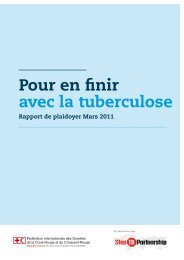Thailand - Stop TB Partnership
Thailand - Stop TB Partnership
Thailand - Stop TB Partnership
You also want an ePaper? Increase the reach of your titles
YUMPU automatically turns print PDFs into web optimized ePapers that Google loves.
Executive Summary<br />
Tuberculosis incidence in <strong>Thailand</strong>, which fell by 50 percent from 1985 to 1991, rose again<br />
in the 1990s with the emergence of the HIV/AIDS epidemic. Today <strong>Thailand</strong> has an incidence<br />
rate of 142 cases per 100,000 people, and is 18th on the World Health Organization’s<br />
list of high-burden countries.<br />
<strong>Thailand</strong>, through the National Tuberculosis Programme (NTP), has committed<br />
itself to implementing the internationally recommended DOTS strategy, which emphasizes<br />
directly observed treatment, and achieving the international <strong>TB</strong> control targets of 70 percent<br />
detection rate and 85 percent treatment success rate. The government reports considerable<br />
progress in meeting these goals: 100 percent DOTS coverage by 2002; and, more recently,<br />
a 71 percent detection rate and 73 percent treatment success rate.<br />
Some Thai experts, however, question the reliability of these statistics. DOTS coverage,<br />
detection, and treatment vary widely from place to place in <strong>Thailand</strong>. The 73 percent<br />
treatment success rate masks rates as low as 25 percent among some vulnerable groups such<br />
as migrant workers and injection drug users. In addition, since detection and treatment rely<br />
only on one form of diagnosis (active, sputum smear-positive cases), the overall treatment<br />
success rate for those with active <strong>TB</strong> may be considerably lower.<br />
Budget reductions resulting from health care reforms have had a dramatic impact<br />
on the NTP’s capacity to fight <strong>TB</strong>, particularly with regard to monitoring and evaluation,<br />
staffing, training, and public awareness-raising efforts. The integration of <strong>TB</strong> and HIV/AIDS<br />
departments at the central level appears to have resulted in <strong>TB</strong> being overshadowed by the<br />
more powerful AIDS program, rather than becoming its equal partner.<br />
Civil society actors, such as recovered <strong>TB</strong> patients and community health activists,<br />
do not play an active role in <strong>TB</strong> policy development. The NTP’s media outreach efforts have<br />
been minimal, and few nongovernmental organizations (NGOs) have initiated <strong>TB</strong> advocacy<br />
and treatment education efforts.<br />
In the absence of easily accessible, accurate information about <strong>TB</strong> and <strong>TB</strong>/HIV,<br />
public awareness of the basic facts about <strong>TB</strong>—and the serious threat <strong>TB</strong> poses to public<br />
health—is low. <strong>TB</strong> is widely viewed as a curable but rare disease. Stigmatization of people<br />
living with <strong>TB</strong> and <strong>TB</strong>/HIV, and of women in particular, is an issue of concern.<br />
Increased NTP funding and support for advocacy, communication, and social<br />
mobilization activities could play a crucial role in addressing many of these concerns. Key<br />
activities could include the following:<br />
• Establish and staff a specialized department within the NTP to oversee the development<br />
and implementation, in partnership with community representatives, of a<br />
plan to increase public awareness about <strong>TB</strong> and <strong>TB</strong>/HIV.<br />
36<br />
<strong>TB</strong> POLICY IN THAILAND



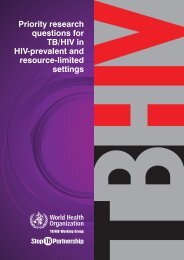
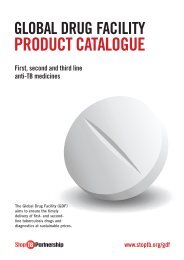
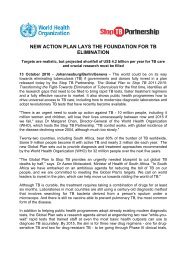
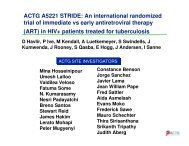
![Global Drug Facility Annual Report 2011 [.pdf] - Stop TB Partnership](https://img.yumpu.com/26788745/1/184x260/global-drug-facility-annual-report-2011-pdf-stop-tb-partnership.jpg?quality=85)

![Concept note on national stop TB partnership [.pdf]](https://img.yumpu.com/26788741/1/184x260/concept-note-on-national-stop-tb-partnership-pdf.jpg?quality=85)
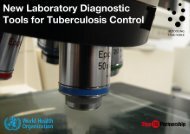

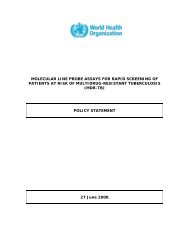
![2005 and Challenges for 2006 - 2015 [.pdf] - Stop TB Partnership](https://img.yumpu.com/26788674/1/190x245/2005-and-challenges-for-2006-2015-pdf-stop-tb-partnership.jpg?quality=85)
![Brochure (French) [.pdf] - Stop TB Partnership](https://img.yumpu.com/17234792/1/190x91/brochure-french-pdf-stop-tb-partnership.jpg?quality=85)

